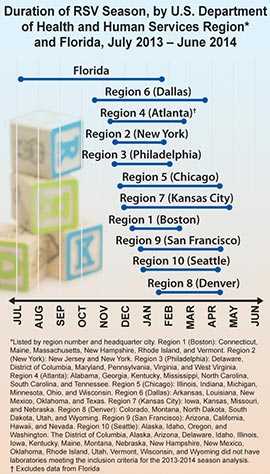Trends and Surveillance
Each year, on average, in the United States, RSV leads to—
- 2.1 million outpatient visits among children younger than 5 years old1
- 57,527 hospitalizations among children younger than 5 years old1
- 177,000 hospitalizations among adults older than 65 years2
- 14,000 deaths among adults older than 65 years2
In the United States and other areas with similar climates, RSV infections occur primarily during fall, winter, and spring.
Footnotes
1Hall CB, Weinberg GA, Iwane MK, Blumkin AK, Edwards KM, et al. The burden of respiratory syncytial virus infection in young children. New Engl J Med. 2009;360(6):588-98.
2Falsey AR, Hennessey PA, Formica MA, Cox C, Walsh EE. Respiratory syncytial virus infection in elderly and high-risk adults. New Engl J Med. 2005;352(17):1749-59.
RSV Seasonal Trends

CDC analyzes data on RSV activity at the national, regional, and state levels, collected by a surveillance system called the National Respiratory and Enteric Virus Surveillance System (NREVSS).
For 2013 to 2014, the RSV season onset ranged from late October to late January, and season offset ranged from late January to early April in all 10 U.S. Department of Health and Human Services (HHS) regions, except Florida. Florida has an earlier RSV season onset and longer duration than the rest of the country (see figure).
Seasonal patterns remained consistent with previous years.
Surveillance Systems
CDC collects information on cases and outbreaks of RSV infection in the United States using the National Respiratory and Enteric Virus Surveillance System (NREVSS). This is a voluntary, laboratory-based surveillance system that was established in 1989 to monitor trends in several viruses, including RSV. NREVSS tracks the number of RSV tests that are done by participating laboratories and the proportion that are positive, by specimen type, location, and when they were collected. Serotyping, demographic data, and clinical data are not reported. Data from NREVSS provides information to public health officials and healthcare providers about the presence of RSV in their communities.
References
- Centers for Disease Control and Prevention. Respiratory Syncytial Virus Circulation in the United States, July 2012–June 2014. MMWR. 2014;62:141-4.
- Centers for Disease Control and Prevention. Respiratory Syncytial Virus Activity — United States, July 2011–January 2013. MMWR. 2013;62:141-4.
- Centers for Disease Control and Prevention. Respiratory Syncytial Virus Activity — United States, July 2007–June 2011. MMWR. 2011;60:1203-6.
- Centers for Disease Control and Prevention. Respiratory Syncytial Virus Activity — United States, July 2008–December 2009. MMWR. 2010;59:230-3.
- Page last reviewed: March 7, 2017
- Page last updated: March 7, 2017
- Content source:


 ShareCompartir
ShareCompartir